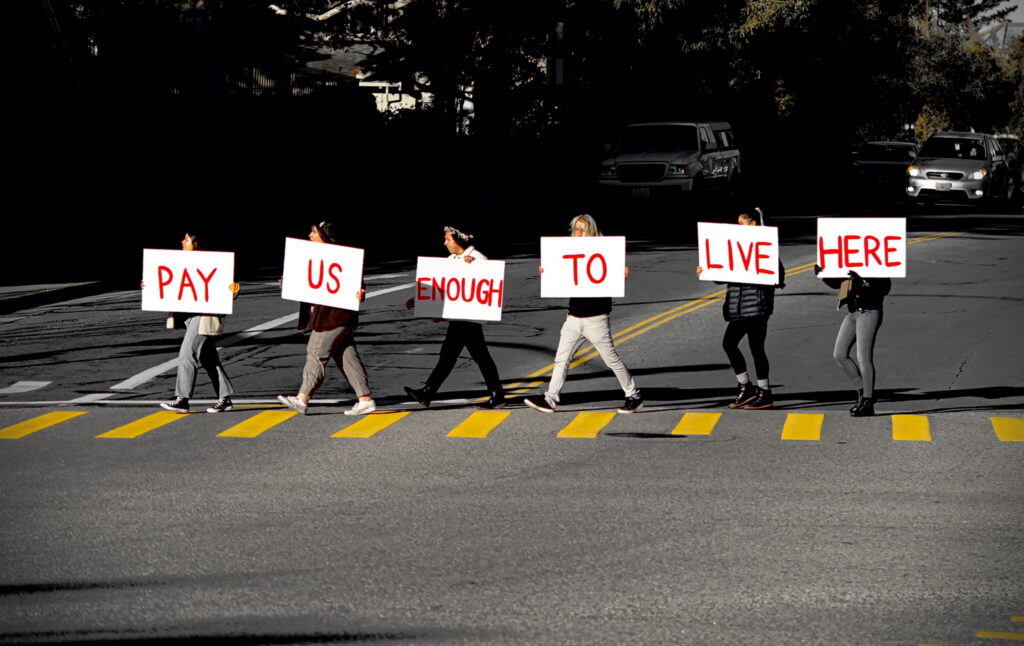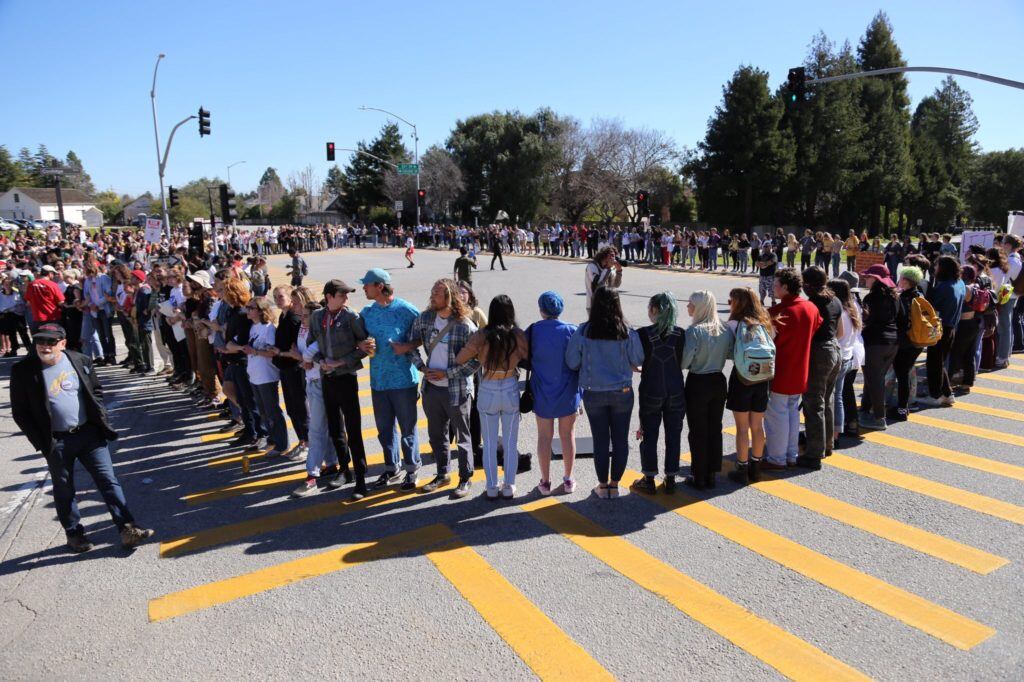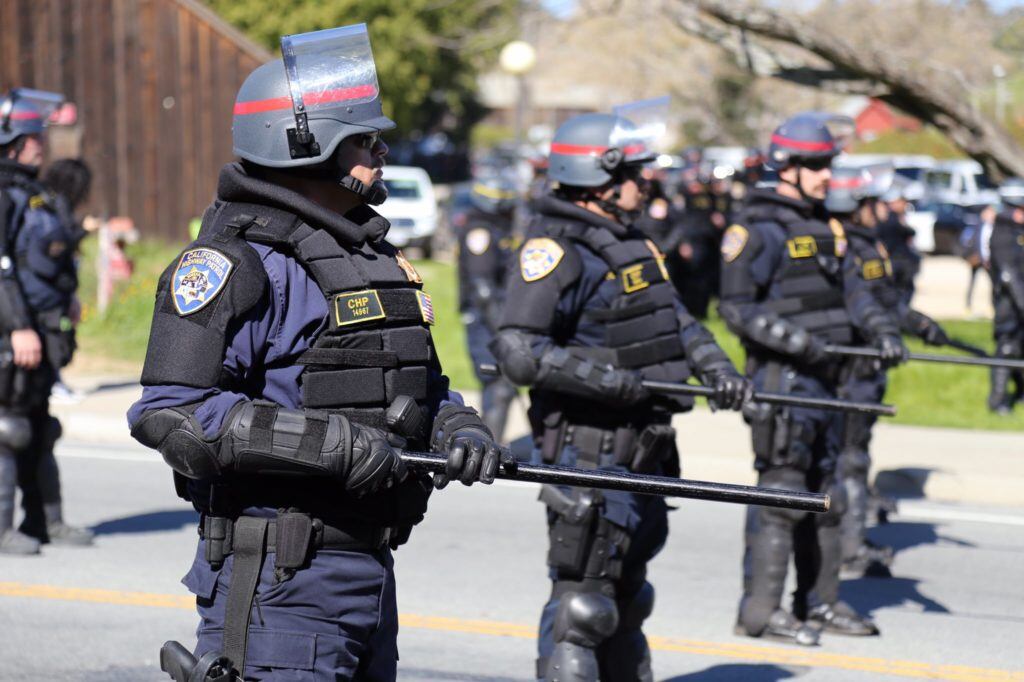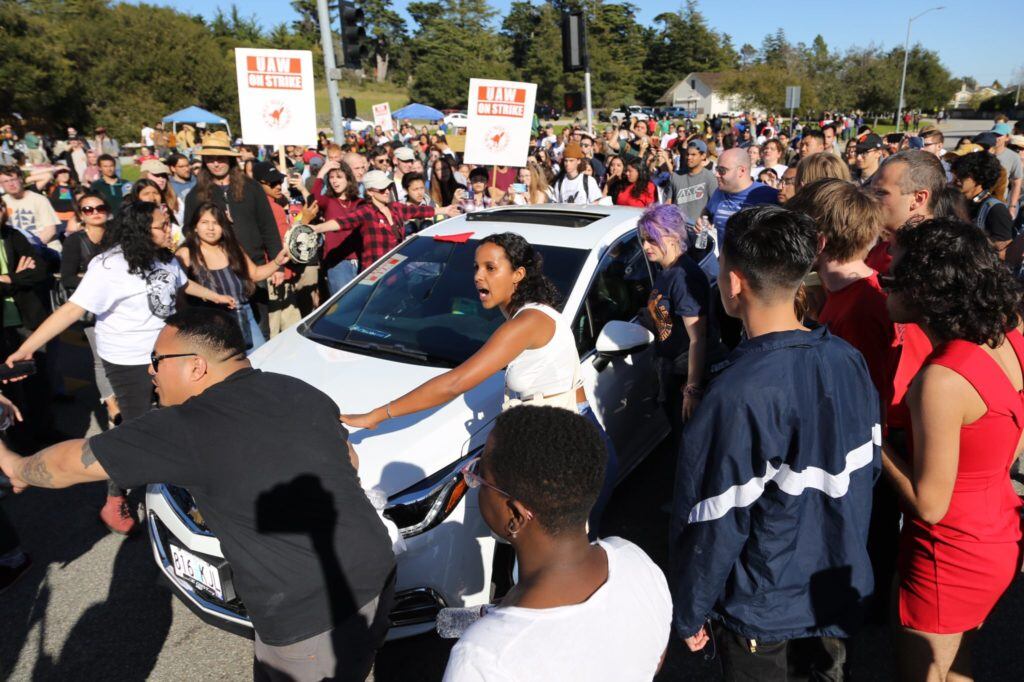
Why Should You Care About the UCSC Strike?
Spoiler: The ongoing wildcat strike by grad students in Santa Cruz holds important lessons for workers of all backgrounds.
Last December, hundreds of graduate students at the University of California-Santa Cruz (UCSC) voted to go on strike. Their sole demand was a cost of living adjustment (COLA) to their monthly stipend. Santa Cruz, a tech hub near Silicon Valley and San Jose, gets more expensive every year. The current base stipend—which comes out to roughly $21,906 per year—is not nearly enough to live on. A 2017 survey found that a grad student in the Santa Cruz area would need at least $32,000 to make it through the year on a barebones budget.
You don’t need a PhD in calculus to see the problem here. But if you’re one of the 87 percent of Americans who don’t have a graduate degree, or one of the 46.5 percent who make less than $30,000 a year, you might find it hard to care. And even if you can relate to the UCSC students’ struggles, you might be wondering why they deserve your attention right now.
After all, this is a presidential election year featuring an authoritarian Republican billionaire trying to buy the Democratic nomination, a scandal-prone corporate consultant-cum-temporary troop possibly trying to ratfuck his way to that same nomination, and an “opposition” party that seems categorically incapable of offering any real opposition to Donald Trump and all the racist, imperialist, misogynist, climate change-denying energy he embodies. Plus, there’s the U.S.’s ongoing attempt to goad Iran into another endless war and the mysterious menace of the coronavirus, which may or may not be the next global health crisis.
This is to say: It’s a busy-ass world out there, and it’s understandable if a bunch of striking grad students in California have slipped under your radar.
Ever since Ronald Reagan dealt a near-fatal blow to the labor movement in the 1980s, many Americans have been skeptical about the necessity (and the utility) of striking. Right-wing outlets like Fox Business have spent years arguing that strikes “[hurt] the workers they’re supposed to help.” Even among leftists who are inclined to empathize with workers fighting for better conditions, grad students—who occupy a curious niche as both service-providing instructors and service-receiving researchers—don’t inspire the same reflexive solidarity as maintenance staff or K-12 teachers. Grad students’ work is done in university classrooms, those bastions of privilege and credentialism, and the anti-intellectual tradition in the United States is alive and thriving across the political spectrum.
Still, let me suggest that anyone with at least a casual interest in building a better world should consider paying attention to the UCSC strike, because its influence is already spreading across the mammoth University of California system, and because it’s part of a global trend of university strikes that could reshape higher education in dramatic ways. But most critically of all, the UCSC strike holds a number of illuminating lessons on how ordinary people can build power, and protect themselves against those who seek to take it away.
Here are three of the most important things we can learn from the UCSC wildcat strike:

THE STRIKE SHOWS THAT JUST HAVING A UNION IS NOT ENOUGH
On February 14th, University of California (UC) president Janet Napolitano (yes, that Janet Napolitano, the former Homeland Security chief who oversaw the persecution of 2 million immigrants during her tenure as Obama’s top immigration enforcer) wrote a letter threatening UCSC grad students with “consequences, up to and including the termination of existing employment at the University” if they refused to abandon their strike. But, since it was Valentine’s Day, she started by offering some perfunctory love for unions. She also provided a clear example of why the mere existence of a union isn’t enough to protect workers from exploitation.
According to Napolitano, while “the University of California respects its labor unions and its unionized workers,” that respect is dependent on the collective bargaining agreement (CBA) signed by university administrators and union leaders. In theory, the CBA safeguards both the rights of workers and management’s peace of mind. However, a wildcat strike (i.e., one that hasn’t been approved by the union) violates that fragile truce, leaving the administration with no choice but to crack down on its unruly workforce. But hey, they’re doing it out of respect and love.
The CBA itself, however, is a matter of some contention. When it was ratified in 2018 by the United Automobile Workers (UAW)—the union that also represents UCSC grad students—nearly 83 percent of Santa Cruz grad students opposed the contract on the grounds that it didn’t account for the drastically higher cost of living in Santa Cruz compared with other campuses. However, because the contract was approved by other UC chapters and the union as a whole, students at UCSC were stuck with an agreement they hadn’t actually agreed to.
As Jane Komori, one of the organizers of the wildcat strike, told me via email, this puts both students and union leaders in an awkward position. “Our strike is unsanctioned by our union, and we are in violation of our contract, which contains a no-strike clause,” she said.
The union has only been “variously supportive” of the grad students’ efforts. Komori says that while UAW “cannot outwardly approve of our strike … they have been helping by filing grievances for students who have received warning letters and other retaliation and by opening up discussions with UC Labor Relations.” Indeed, shortly after Napolitano threatened to terminate the employment of striking UCSC grad students, a union representative responded with a letter outlining how administrators were themselves violating the terms of the collective bargaining agreement by threatening to fire students without cause.
Sound complicated? It is! The saga unfolding in Santa Cruz illustrates how the aims of union leadership and its rank-and-file members aren’t always in harmony (a conflict that was recently highlighted when one of the country’s most powerful unions came out against Medicare for All, despite the huge benefits M4A would have for its membership). It also shows how important internal agitation is for workers seeking to make their union a tool for empowerment. Wildcat strikes like the one at UCSC are an enormously powerful tool for workers to ensure their union leaders fulfill their real obligations. When Bernie Sanders recently endorsed the UCSC strike, he didn’t do so because of pressure from a handful of high-ranking UAW reps. Instead, bottom-up organizing got attention and earned UCSC students this major political endorsement.
Fighting for the right to unionize is an important first step for any group of workers. But the work doesn’t end there—a union’s real strength comes not from the contracts it signs, but from the ferocity and courage of its members.

THE STRIKE EXPOSES MANAGEMENT’S AGE-OLD LIE: “WE JUST DON’T HAVE THE MONEY“
As mentioned before, the sole demand of the UCSC wildcat strike (now entering its second month of action) is a cost-of-living adjustment, which the strikers have pegged at $1,412 per student each month. With around 1,800 grad students currently enrolled, this comes out to a little over $2.5 million per month.
That might sound like a lot of money to little ol’ barely-making-rent you and me. However, when you consider that nearly 600 UC administrators make salaries over $500,000 per year—amazingly, Napolitano’s salary of over $570,000 doesn’t even put her in the top 375 of UC administrators—it starts to sound much less daunting.
While the university pleads poverty to avoid meeting the demands of its penniless grad students, it continually splashes money at expenditures that seem at odds with its mission of enlightenment and learning. Although UC claims it can’t find the funds to ensure its workers have a place to sleep and enough to eat, it had no problem scrounging up enough cash to bus in police mercenaries from across the state in an effort to suppress the strike.

According to Komori, “There were hundreds of cops on campus [when the strike started], and there are still large numbers of them [today]. Our Executive Vice Chancellor Lori Kletzer told us herself last week that this level of police presence costs $300,000 per day, totaling $1.5 million per week.”
As you might expect, those cops aren’t idly standing by while strikers sing songs and wave picket signs. Here’s how Komori described the scene on campus:
“After we peacefully closed the main entrance to campus … dozens of cops donned riot gear for the rest of the week, and came out armed with batons, cuffs, pepper spray, face shields, and body armor, on top of their regular gear. During arrests [several days later], 17 peaceful protesters, graduate and undergraduate students, were arrested. Cops used pain compliance techniques to wrench protesters from the circles they sat in with linked arms. One had her finger broken, another sustained head injuries, and many others reported bruising and soreness. This level of violence is entirely unwarranted, and makes very plain the administration’s contempt for students and workers.”
It also makes plain the utterly batshit financial priorities of UC and other large, powerful institutions. Rather than provide their grad student workers—people whose efforts, skills, and services generate much of the value that makes those institutions viable in the first place—with a living wage, administrators would rather use that money to intimidate those workers (and, of course, to subsidize administrators’ own lavish lifestyles).
So the next time you hear a high-ranking official claim “we simply can’t afford to [do thing that would benefit workers],” your first question should be:
Well, what else are you spending your money on? Do you really need those things? Whatever happened to fiscal responsibility?

THE STRIKE DEMONSTRATES HOW TO BUILD SOLIDARITY AMONG GROUPS MANAGEMENT SEEKS TO DIVIDE
Any time a group of workers goes on strike, one of the first classic management responses is to accuse the workers of selfishness. When overworked nurses seek a saner workload, they’re blamed for neglecting their patients. When transit workers fight for pensions and healthcare, they’re criticized for complicating the lives of commuters. Predictably, when the UCSC grad students went on strike—which included withholding grades and refusing to teach formal classes—administrators attacked them for harming undergraduates.
Napolitano has specifically accused the strikers of “holding undergraduate grades hostage.” Executive Vice Chancellor Lori Kletzer was even more explicit in a letter she sent to UCSC faculty, in which she urged them to pressure their teaching assistants into giving up the strike.
“The grading, and now teaching, strike disrupts our educational mission and imposes costs on students, particularly our undergraduate students,” wrote Kletzer. “[The] approach taken by our striking graduate student employees is having a significant negative impact on the emotional well-being and academic success of our undergraduate students, our dedicated staff who have gone above and beyond to mitigate the consequences, and the very mission of our campus.”
According to Kletzer and other administrators, the wildcat strike jeopardizes undergraduates’ ability to receive financial aid, complete their degrees, and even to learn at all. And teaching assistant strikes obviously make the lives of faculty members a hell of a lot more complicated.
It’s interesting, then, that both undergraduate students and faculty members have been outspoken in their support of the UCSC wildcat strike, penning letters to the administration in which they protest against the treatment of striking grad students and resist administrators’ efforts to pit them against each other. As the Faculty Organizing Group wrote, “The administration’s proposed action will cause deep and lasting harm to both undergraduate and graduate education at UCSC (well beyond the disruption currently caused by the Teaching Assistants’ strike).”
This solidarity didn’t just arise from some nebulous notion of “good vibes.” The striking grad students at UCSC have been actively seeking to both mitigate the impact of the strike on their students and co-workers, and to help them understand why it was necessary in the first place. As Komori explains, the strikers have “been working tirelessly to support undergraduates who need their grades submitted for reasons related to financial aid.” Not only that, but they have “created materials to help undergraduates understand the strike and impact on them…and maintained a policy that should students ask to know their grade personally or to have it submitted, that we will do so, no questions asked.”
In addition, UCSC’s striking grade students have held “teach-ins”—covering both the strike itself and topics related to fighting exploitation—and hosted extended “strike office hours” so that undergrads don’t feel abandoned by their instructors.
The end result, according to Komori, is that “many undergraduate students have actually asked for their grades to be withheld in a show of solidarity and support.”
Any strike will inevitably cause disruptions to the lives of people who aren’t responsible for the strike’s necessity, and it’s easy for this to breed ill will and resentment among those caught in the crossfire between strikers and management. However, the example provided by the UCSC strike shows that open and honest communication with the people impacted by a strike—as well as a willingness to be physically present with them if needed—can be powerful tools in countering any attempt by management to sow division.

A FINAL THOUGHT
Even if you find all the arguments above to be persuasive (and I hope that you do), it’s still unlikely that the UCSC strike will magically skyrocket to the top of your List of Things to Be Righteously Angry About. And that’s okay! There’s no shortage of injustices to boil your blood right now, and some of them might hit closer to home.
Still, the UCSC grad students have taken a brave and principled stance against a powerful foe, and we should support them in whatever way we can. Maybe that involves contributing a few dollars to their strike fund, or maybe it’s as simple as voicing your support for the strike on social media.
Above all, we should make a place in our hearts for our fellow workers at UCSC. The appeal of the socialist movement comes not only from its ability to win material gains—which are very important!—but also from its ability to offer us a healthier, more empathetic, sincerely loving way to relate to other people. To paraphrase the immortal words of Ralph Chaplin: When we’re animated by a genuine love for those around us, there’s no power greater anywhere beneath the sun.
Main photo: Stephan Bitterwolf
Correction: This article originally overstated the amount of the base stipend. According to UCSC strikers, it is $21,906 rather than $29,000.

Cover photo taken by Stephan Bitterwolf.




